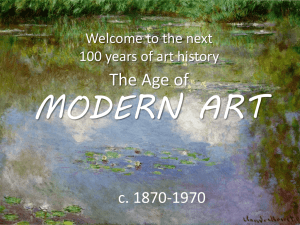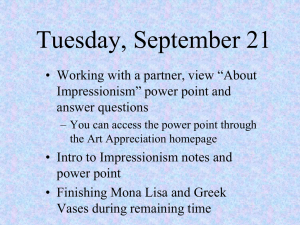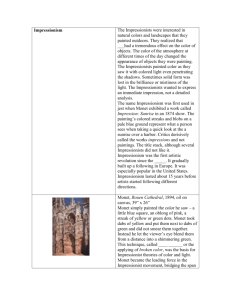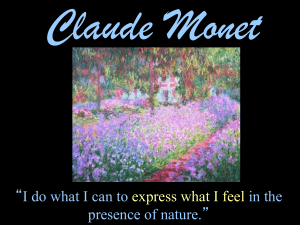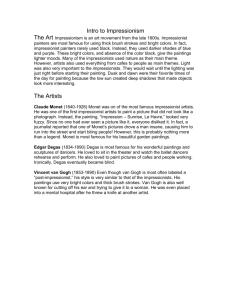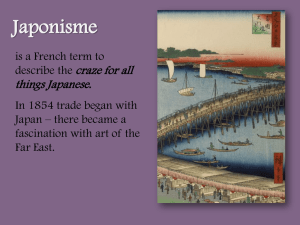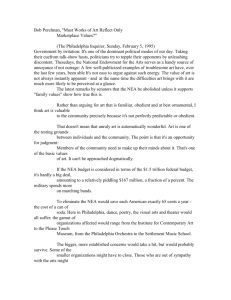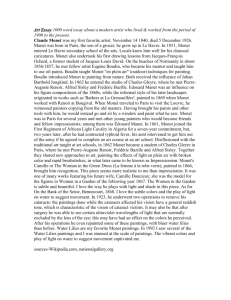Chapter 13—The Working Class and the Bourgeoisie
advertisement
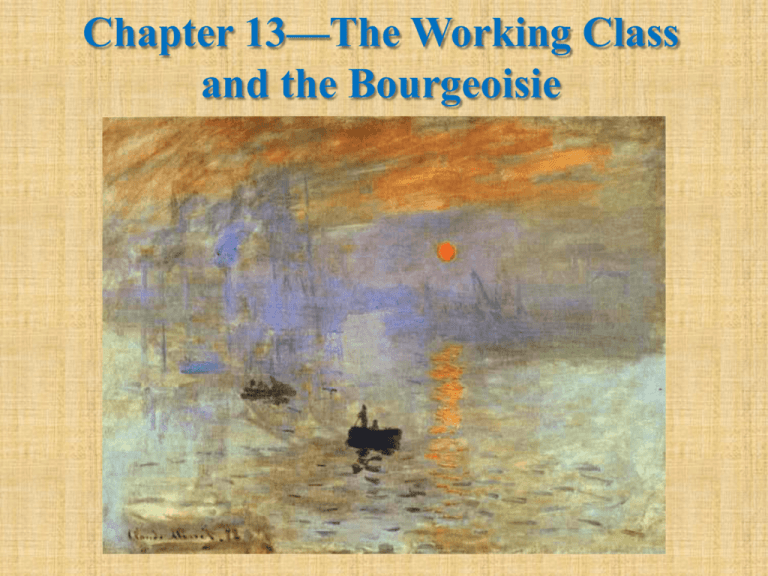
Chapter 13—The Working Class and the Bourgeoisie The Times—1850 to WWI • The world was on the move across borders. This included the great migrations to America and social unrest within borders. • Science expanded: Planck, Einstein, Roentgen, Mendel. • Thought: Nietzsche and Freud • In the arts, there was the argument of functionalism vs. aestheticism: Does art have to have a purpose or is it enough that it is? The Times—1850 to WWI (cont.) • Cities were growing horribly with garbage, illness, death, and poverty. • The banking system was as chaotic as life in general. • Cities of leisure produced suburbs for industry and people. • The Gilded Age, robber barons, ostentatious behavior of a very few rich and poverty for the masses THE NEW REALISM • Realism covered the middle years of the 19th century. • Adam Smith and less government control • Marxism: Marx and Engel + Hegel = dialectical process • Communism developed in London, England due to the Industrial Revolution. Literary Realism--England Charles Dickens writes of the poor city dwellers of especially London’s Drury Lane. Literary Realism--France Honore de Balzac Gustave Flaubert Literary Realism--US Slavery was the central issue for America during that time period. Narrative of the Life of Frederick Douglas was his autobiography of life as an American slave. “You have seen how a man was made a slave; you shall see how a slave was made a man.” Fredrick Douglas It is interesting that the sermon/speech, “Ain't I a Woman?”, by Sojourner Truth doesn’t contain that phrase. It might have been added years latter by Frances Gage. Regardless, it was a powerful speech on equality of women …whether black or white. Oliver Gilbert Stowe was a social activist especially regarding slavery. She wrote Uncle Tom’s Cabin in 1852. Harriet Beecher Stowe A decade later, she met with Lincoln in the White House, and he was alleged to have said, “… so you are the little woman who wrote the book that started this great war.” Adventures of Huckleberry Finn was a Stephen Colbert-esque novel about slavery. Unfortunately, many missed the entire message. Samuel Clemens aka Mark Twain Realist Art: The Worker as Subject Lithography is essentially a process of engraving on stone or metal. Daumier mastered the art form. Daumier The Fugitives 1868 Courbet The Stone Breakers 1849 Courbet Woman with a Parrot 1866 Daguerre Le Boulevard du Temple 1838 Paul Delaroche was a French painter who said of the daguerreotype, “From now on, painting is dead!” At one level, Delaroche was correct. However, what happened was that painting changed… enter Impressionism. Mathew Brady Brady’s vision of the Civil War Tanner The Banjo Lesson 1893 Tanner The Thankful Poor 1894 In Pursuit of Modernity: Paris in the 1850-60s Edouard Manet: The Painter of Modern Life It was an age of painting everyday life of the everyday person in the modern city. He certainly was dissing the bourgeoisie lifestyle. Flaneur = a person observing life Manet Luncheon on the Grass 1863 Manet Café Concert Manet Le Bar aux Folies-Bergère Manet Moonlight Harbor Manet Grand Canal Manet Street Flags Manet Olympia 1865—a result of the American Civil War Nationalism and the Politics of Opera Nationalism and aristocracy became a part of art in Europe. Verdi was into drama, spectacular, and realism in opera. Giuseppe Verdi Verdi Triumphal March of Aida Wagner was into was on the cutting edge and opulence. He emphasized music over voice. Richard Wagner Wagner Ride of the Valkyries / William Maud’s painting Impressionist Paris • In 1874, Impressionism was named. • Impressionism—concerned with subjectivity, realism of light, not camera pictures, fingers point to subject in realism and in impressionism light points to feelings or impressions. • Looked for the impression at the very moment of sight • The camera freed artists from competing with realism. Manet was the inspiration for a group of artistic young Turks: Monet, Renoir, Caillebotte, Degas, Morisot. However, note the similarities with the British painter Turner. Monet’s Plein-Air Vision-- open air painting Light was essential and the tubes of paint allowed them to paint outside with light. Monet attempted to stay away from the city and pollution. He moved to Argenteuil and finally to Giverny to avoid crowds. This gave him unimpaired light. This can be seen in Monet’s interest in haystacks— trust me. From 1888-91, Monet painted different haystacks—in different light. Monet Haystacks, At the End of Summer 1890 Monet Wheat Stacks 1890-91 Monet Impression: Sunrise The first impressionistic painting. Monet Garden at Sainte-Adresse Monet La Rue Montorgueil, 30th June 1878 Monet Poppies near Argenteuil Monet Boulevard des Capucines 1873 Monet Grand Channel 1908 Monet Saint-Lazare Station Monet Saint-Lazare Station Monet Houses of Parliament 1904 Monet Water Lilies Monet Water Lilies and Clouds Monet The Thames at Westminster Monet Willows Monet Antibes, The Mountains of Esterel Monet The Japanese Bridge 1905 Monet Woman with a Parasol Monet In the 'Norvégienne' Monet Water Lilies Monet Argenteuil 1875 Monet Morisot Summer’s Day 1879 Morisot Manet and His Daughter at Bougival Pissarro Red Roofs 1877 Pissarro The Road to Louveciennes Renoir and Degas liked the Parisian scene and crowds— as opposed to Monet, Morisot, and Pissarro. Renoir suffered from arthritis. However, he said, “The pain passes, but the beauty remains.” Renoir Renoir Le Moulin de la Galette Renoir Claude Monet Reading 1872 Renoir Dance at Bougival 1883 Renoir Claude Monet Painting in His Garden at Argenteuil 1873 Renoir Renoir Renoir Girls Reading Renoir Renoir Renoir Renoir Renoir Degas The Star, or Dancer on the Stage Degas Degas - Dancer When Lacing the Ballet Shoes Up Degas Degas Degas Degas Frieze of Dancers Degas Degas Degas Degas Degas The Gilded Age in America Central Park in New York attempted to bring sanity and culture to a crowded metropolis. Nevertheless, poverty ran rampant and as a consequence, social unrest resulted. Koehler The Strike 1880 Rodin and his sculpture The Thinker t Rodin Gates of Hell 1879-1889 Rodin Adam Rodin Burgher of Calais Rodin Rodin Woman in a Red Hat Rodin The Kiss Rodin Rodin
